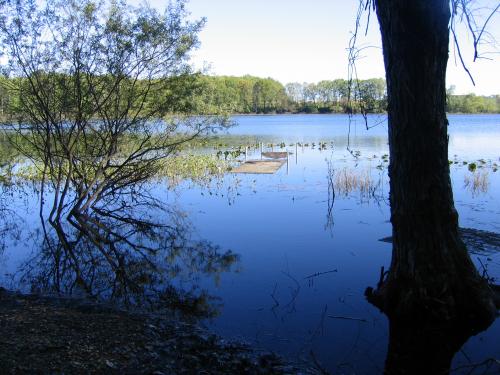Establishing a legal lake level on your inland lake – Part 1
There are pros and cons to artificially manipulating your lake’s water level. For a lake ecosystem it is more con than pro.

Every lake is different in how its level fluctuates in wet and dry years. Some lakes are stable and only have minor changes in water level from year to year. These lakes usually have rivers flowing through them. Consequently, even if the area has had years of low rainfall the river keeps water levels steady.
Photo at right: Submerged dock on a natural, groundwater seepage lake.
Conversely, lakes fed by streams and rivers usually have larger watersheds and would be expected to respond more rapidly to precipitation events – possibly resulting in short-term flooding.
Seepage lakes that are primarily fed by groundwater may also rise and fall between wet and dry years but usually respond more slowly to precipitation events as the rainfall has to infiltrate into the ground and then enter the lake through underground springs.
Dramatic changes in water level can impact shoreline uses and recreational activities.
Many natural lakes (and even large wetlands) have been equipped with legally established level control structures for the purpose of seasonally manipulating water levels. For example, a level control structure may be operated to maintain a higher water level in the summer to accommodate recreational boating and a lower level in the winter to reduce ice damage to shoreline properties.
It is sometimes possible for communities to minimize the dramatic fluctuations in water level by enacting a legal lake level. A study should be done to determine the environmental and economic feasibility of such an action and the viability of managing a lake’s water level once a level control structure has been installed. Although boaters may benefit from a more stable summer water level, most lake ecosystems won’t. Many cases of shoreline erosion can be attributed to the repeated and unnatural seasonal manipulation of lake levels. Entire communities of emergent aquatic plants (providing important habitat for fish, frogs, dragonflies and waterfowl) have been known to disappear when water levels are artificially raised. And during drought conditions, wetlands and waterways downstream of a level control structure may be adversely affected by the inability of water to naturally flow through the system.
Read the Michigan State University Extension article The ups and downs of Michigan inland lake levels for background information on lake types and why your lake may be responding to precipitation events in the way that it does. Those interested in the process involved in establishing a legal lake level should watch for the upcoming Part 2 of this article.



 Print
Print Email
Email


